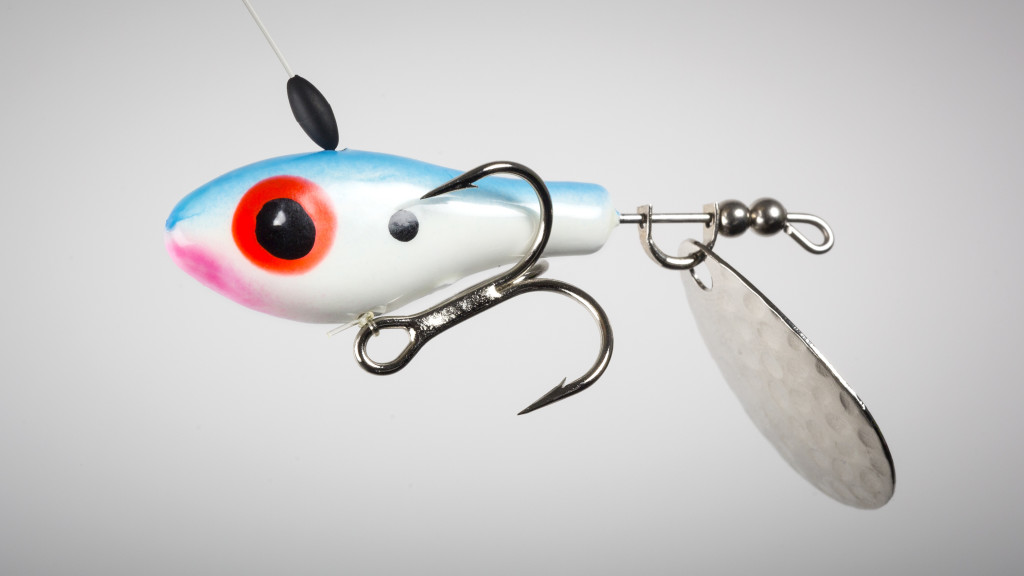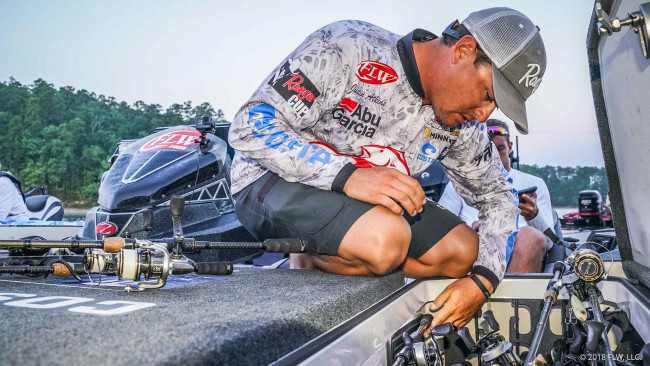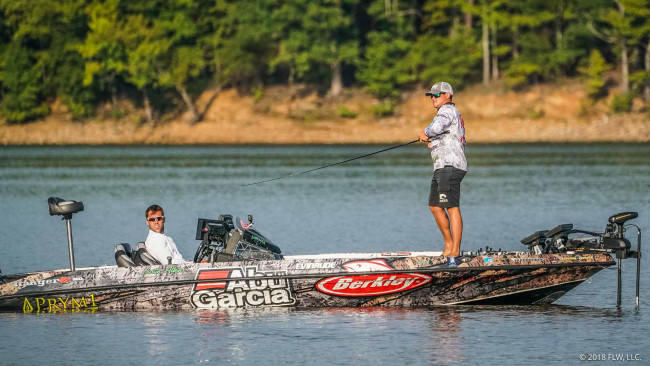Revival of the Tail Spinner?
Justin Atkins’ third-place finish at Ouachita might just bring it back

Bass fishing in the heat of summer necessitates a flexible approach. Sure, there are baits and patterns that almost always catch fish – frogs and buzzbaits, deep-diving crankbaits, big worms and jigs – but when the fish get extra finicky, what separates the good from the great is the ability to find bites with unconventional methods.
Thinking outside the box is what helped Alabama pro Justin Atkins lock down a third-place finish at the 2018 Forrest Wood Cup on Lake Ouachita. His weapon of choice for targeting suspended and schooling bass: a tail spinner.
“They [tail spinners] are something I just always used growing up,” Atkins says. “That’s a big Mississippi thing. Over on the reservoirs – Ross Barnett, Grenada, Sardis, all those places – those fish school a lot, and they school on really small bait. It’s a great bait to throw at them.”
Although a fairly uncommon bait by today’s tournament fishing standards, the tail spinner is still a highly effective lure with a ton of useful applications. And perhaps the biggest appeal of throwing one now is that so few fish have seen them before.
The rub on tail spinners
One jighead, one treble hook and one Colorado blade. Tail spinners are as simple as it gets. They’re heavy for their size and can be absolutely deadly when fish are feeding on small shad.
When long casts and retrieves are crucial for putting baits in the middle of a school or an offshore target in deep water, they’re a perfect fit.
“You can throw it a really long way,” Atkins adds. “You can throw it a lot farther than you can a topwater, and it’s really small so it mimics the bait. Plus, when they come up and aren’t up for very long, it’s something you can get out there quick.”

The setup
Because of the heft of the jighead on a tail spinner (usually 1/2 or 3/4 ounce), a casting setup is usually the best approach. Atkins’ favorite is a custom Collum Enterprises Whing Ding tail spinner. He throws it on a 7-foot, medium-action Abu Garcia Villain 2.0 casting rod. It’s a setup that landed him one or two limit fish per day and “20 or 30” fish in total at Ouachita.
“I like a rod that’s got a little bit of tip so you can really whip it out there, but at the same time, you’re still throwing a treble-hooked bait, and so you can’t throw it on too stiff a rod or you’ll lose every one of them,” he says.
Atkins rigs his custom tail spinner on 12- to 15-pound-test fluorocarbon depending on the size of fish he’s targeting, and in most cases fluorocarbon is the best option given that rate of fall and line visibility are keys to a good presentation.

How to fish it
The options for tail-spinner presentations are many, from a fast, steady retrieve for schooling bass to a jigging spoon-like approach lower in the water column. You can swim it, rip it, jig it – whatever the fish are after at any given time.
“With it also being heavy, you can fish it like a jigging spoon,” Atkins says. “If those fish come up and bust and go down, I might throw it out there and click my spool and let it fall. With a little bit of tension, I can tell if I get a bite. A lot of times they bite it when it’s sinking out there.”
While some tail spinners are built with fixed line ties and hook hangers, the one Atkins uses is a line-thru model. The line passes through the body and connects to a free-hanging treble hook. The body is able to slide free when fighting a fish for improved landing percentages.
When using the line-thru type, Atkins has one crucial tip for making the most of every cast.
“A lot of times when you cast it your hook will try to come up and catch your line,” he says. “And then you’ve wasted a whole cast. You’ve thrown it 80 yards out there, and your bait is fouled up.”
The secret, he says, is to use a bobber stop to position the treble hook so that it isn’t hanging down freely when casting and reeling, and he has a trick to hold it horizontal with the bait and “tucked under” the head.
“The deal is to put a bobber stop on it, run your line through the Whing Ding and then tie to the treble hook so your Whing Ding free-slides on the line,” Atkins says.
Atkins ties his knot to the side of the hook’s eye, which positions the hook shank perpendicular to the line and parallel to the lure’s body.
“You want to take your treble hook – you have two prongs that are parallel and one that’s kind of a solo – and put the solo one down,” he adds.
Once positioned correctly, he snugs everything in place by sliding the bobber stopper down against the top of the bait.
“That keeps your hook in a backward posture while you’re fishing with the bait.”
Poised for a revival?
Tail spinners aren’t new, nor is the idea of catching lots of big fish with them. For whatever reason, they simply fell out of style for many modern tournament anglers.
Atkins isn’t the only angler throwing a tail spinner, and he certainly won’t be the last. With his recent success leaning heavily on one at Ouachita, there’s a good chance we’ll see more pros digging through boxes of old tackle to make sure they have one or two with their tournament gear.